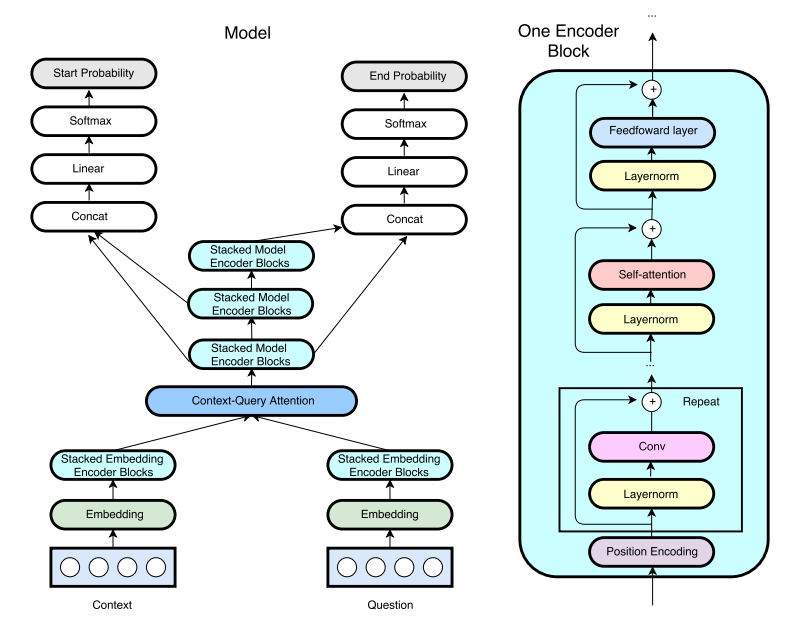NLPLearn / Qanet
Programming Languages
Labels
Projects that are alternatives of or similar to Qanet
QANet
A Tensorflow implementation of Google's QANet (previously Fast Reading Comprehension (FRC)) from ICLR2018. (Note: This is not an official implementation from the authors of the paper)
I wrote a blog post about implementing QANet. Check out here for more information!
Training and preprocessing pipeline have been adopted from R-Net by HKUST-KnowComp. Demo mode is working. After training, just use python config.py --mode demo to run an interactive demo server.
Due to a memory issue, a single head dot-product attention is used as opposed to a 8 heads multi-head attention like in the original paper. The hidden size is also reduced to 96 from 128 due to usage of a GTX1080 compared to a P100 used in the paper. (8GB of GPU memory is insufficient. If you have a 12GB memory GPU please share your training results with us.)
Currently, the best model reaches EM/F1 = 70.8/80.1 in 60k steps (6~8 hours). Detailed results are listed below.
Dataset
The dataset used for this task is Stanford Question Answering Dataset. Pretrained GloVe embeddings obtained from common crawl with 840B tokens used for words.
Requirements
- Python>=2.7
- NumPy
- tqdm
- TensorFlow>=1.5
- spacy==2.0.9
- bottle (only for demo)
Usage
To download and preprocess the data, run
# download SQuAD and Glove
sh download.sh
# preprocess the data
python config.py --mode prepro
Just like R-Net by HKUST-KnowComp, hyper parameters are stored in config.py. To debug/train/test/demo, run
python config.py --mode debug/train/test/demo
To evaluate the model with the official code, run
python evaluate-v1.1.py ~/data/squad/dev-v1.1.json train/{model_name}/answer/answer.json
The default directory for the tensorboard log file is train/{model_name}/event
Run in Docker container (optional)
To build the Docker image (requires nvidia-docker), run
nvidia-docker build -t tensorflow/qanet .
Set volume mount paths and port mappings (for demo mode)
export QANETPATH={/path/to/cloned/QANet}
export CONTAINERWORKDIR=/home/QANet
export HOSTPORT=8080
export CONTAINERPORT=8080
bash into the container
nvidia-docker run -v $QANETPATH:$CONTAINERWORKDIR -p $HOSTPORT:$CONTAINERPORT -it --rm tensorflow/qanet bash
Once inside the container, follow the commands provided above starting with downloading the SQuAD and Glove datasets.
Pretrained Model
Pretrained model weights are temporarily not available.
Detailed Implementaion
- The model adopts character level convolution - max pooling - highway network for input representations similar to this paper by Yoon Kim.
- The encoder consists of positional encoding - depthwise separable convolution - self attention - feed forward structure with layer norm in between.
- Despite the original paper using 200, we observe that using a smaller character dimension leads to better generalization.
- For regularization, a dropout of 0.1 is used every 2 sub-layers and 2 blocks.
- Stochastic depth dropout is used to drop the residual connection with respect to increasing depth of the network as this model heavily relies on residual connections.
- Query-to-Context attention is used along with Context-to-Query attention, which seems to improve the performance more than what the paper reported. This may be due to the lack of diversity in self attention due to 1 head (as opposed to 8 heads) which may have repetitive information that the query-to-context attention contains.
- Learning rate increases from 0.0 to 0.001 in the first 1000 steps in inverse exponential scale and fixed to 0.001 from 1000 steps.
- At inference, this model uses shadow variables maintained by the exponential moving average of all global variables.
- This model uses a training / testing / preprocessing pipeline from R-Net for improved efficiency.
Results
Here are the collected results from this repository and the original paper.
| Model | Training Steps | Size | Attention Heads | Data Size (aug) | EM | F1 |
|---|---|---|---|---|---|---|
| My model | 35,000 | 96 | 1 | 87k (no aug) | 69.0 | 78.6 |
| My model | 60,000 | 96 | 1 | 87k (no aug) | 70.4 | 79.6 |
| My model ( reported by @jasonbw) | 60,000 | 128 | 1 | 87k (no aug) | 70.7 | 79.8 |
| My model ( reported by @chesterkuo) | 60,000 | 128 | 8 | 87k (no aug) | 70.8 | 80.1 |
| Original Paper | 35,000 | 128 | 8 | 87k (no aug) | NA | 77.0 |
| Original Paper | 150,000 | 128 | 8 | 87k (no aug) | 73.6 | 82.7 |
| Original Paper | 340,000 | 128 | 8 | 240k (aug) | 75.1 | 83.8 |
TODO's
- [x] Training and testing the model
- [x] Add trilinear function to Context-to-Query attention
- [x] Apply dropouts + stochastic depth dropout
- [x] Query-to-context attention
- [x] Realtime Demo
- [ ] Data augmentation by paraphrasing
- [ ] Train with full hyperparameters (Augmented data, 8 heads, hidden units = 128)
Tensorboard
Run tensorboard for visualisation.
$ tensorboard --logdir=./

